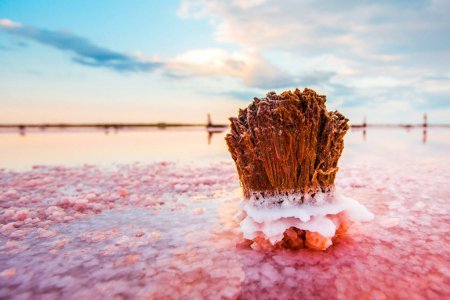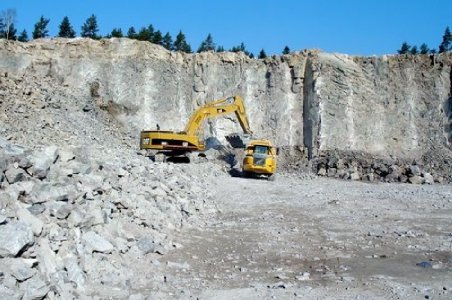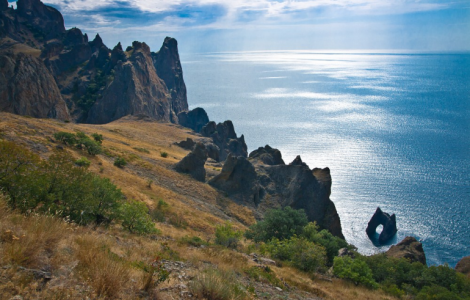The Crimean peninsula is rich not only with gentle sunshine, warm sea, sandy beaches with healthy air, but also with large reserves of mineral resources, the development of which always brought significant incomes. After the annexation, Russia appropriated peninsula’s natural resources and created conditions for an unprecedented plunder of mineral resources.
What resources is the Crimean land rich with?
Crimea was considered one of the richest mineral region of Ukraine. Its coastal area contains oil and gas reserves with a total area of gas and oil deposits of up to 20,000 sq. km. In particular, the claim of the NJSC “Naftogaz” regarding the loss of the company’s Crimean assets contains the information about reserves of 50 billion cubic meters of gas, 3.5 million tons of oil and 1 million tons of gas condensate.
One of the world’s largest iron ore deposits with reserves of more than 2 billion tons is located on the Kerch peninsula. The salt lake brine and Sivash contain sodium, potassium, calcium, magnesium and bromine salts. Sivash magnesium salts produce the brine magnesium oxide used to make high-quality metallurgical refractories.
There is a wide range of natural building materials such as marls, clays, sands and sandstones, gravels, pebbles, diorites, trails, a variety of limestone used as wall stone and facing materials as well as rich deposits of clay that can be used for making bricks and in the chemical and the pharmaceutical industry on the peninsula. In addition, there are numerous water and mineral springs used to treat various diseases in Crimea.
Extractive industry of Crimea: before and after annexation
Crimea developed 1.6 billion cubic meters of natural gas (on the shelf), 1.5 million cubic meters of crushed stone and only 47.9 thousand cubic meters of sand (it is possible to develop 160 thousand cubic meters) in 2013. The extractive sector brought 120 million hryvnas to the budget as taxes in 2013.
After the oсcupation of Crimea by Russia, the extractive industry remains the only more or less profitable industry of the peninsula.
In particular, according to the results of 2014, the extractive industry as a whole showed an increase of 7.2%, and its oil and gas sector – by 14.1% (due to the increase in natural gas extraction from 1.6 billion cubic meters in 2013 to 2 billion in 2014). However, these figures declined slightly and amounted to 1.8 billion cubic meters in 2015.
The situation is a little worse with the quarry development: according to the results of 2014, extraction of minerals in Crimean quarries decreased by 28%. In particular, while 1.5 million cubic meters of crushed stone were developed in 2013, only 1.4 million cubic meters of crushed stone and gravel were extracted in 2014. The same situation is with the extraction of limestone, 2.5 million tons of which were developed in 2013, 1.4 million tons – in 2014 and just 689 thousand tons – in 2015 (the extraction fell by 4 times compared with 2013).
Russian format of using subsurface resources
After the annexation of Crimea, peninsula’s subsurface resources were owned by the Russian state. On May 26, 2014, the Russian Prime-Minister Dmitry Medvedev issued a decree to transfer the control of mineral resources to peninsula’s ‘authorities’ and now the ‘Ministry’ of Ecology and Natural Resources of Crimea controls them.
According to Russian laws, both public and private companies can be engaged in developing subsurface resources on the basis of licenses obtained by the auction (i.e. by tender). In some cases, it is allowed to issue licenses without tendering – for example, to develop subsurface resources under the state order or conduct their geological analysis as well as to construct and use underground structures not related to the management of natural resources.
Ukrainian licenses to develop subsurface resources remain in full effect in Crimea until January 1, 2017. Those who are interested in the development of Crimean mineral resources should obtain Russian licenses in the ‘Ministry of Ecology’ of Crimea during this ‘transition period’. Companies engaged in the development of subsurface resources in water areas of the Black and Azov Seas received Russian licenses in the Russian government by October 1, 2015 (without auction). In total, 45 companies received licenses to develop mineral resources in Crimea within 2015.
In addition, Crimean state unitary enterprises (SUE) and state institutions established by the ‘Council of Ministers’ can receive licenses without any tender for the ‘transition period’ (until January 1, 2017). In other words, the ‘Council of Ministers’ created a loophole to transfer Crimean lands to the entities it controls.
By the way, Ukraine couldn’t abolish the licenses issued for the development of Crimean subsurface resources during two year that have passed since the annexation of Crimea. To tell the truth, some of them have already expired. But, according to the information we got from the State Service of Geology and Mineral Resources of Ukraine, 197 special permits that allow companies to develop mineral resources on the occupied peninsula remain valid as of May 20, 2016. Several special permits are still valid for “Chernomorneftegaz” nationalized by occupants.
Notable cases and secret land distribution
One of the most serious challenges for Crimean ‘authorities’ was the issue related to developing a quarry near Karadag by the LLC “Stroykompress” owned by the son of the Crimean ‘State Council’s’ deputy Frunze Mardoyan.
Environmental experts and the public opposed vigorously as quarrying would lead to the destruction of the reserve. However hard the ‘Minister’ of Ecology Gennady Narayev tried to convince the public that the andesite extraction in the Planerskoye deposit was needed to help Crimea become a self-sufficient region, it didn’t work. Eventually, the ‘head’ of Crimea Sergey Aksenov who personally lobbied for the quarry’s development had to give up – this case received too wide coverage. As a result, the LLC “Stroykompress” was not only refused to quarrying near Karadag, but also later deprived of the license to develop crushed stone in Simferopol area, satisfying requirements of villagers.
In total, the ‘prosecution’ office initiated 15 administrative cases because of a lack of licenses for subsoil use or licensing violations during the first half of 2015. The amount of fines imposed on offenders exceeded 5 million rubles.
However, along with these demonstrative cases, the land for rent is still allocated for a coterie in Crimea. This is evidenced by the case when the ‘Council of Ministers’ allocated 11.8 hectares in the Chernomorsk area for rent to the LLC “Plato” – the company of the former Crimean deputy Konstantin Malchikov called as ‘landlord’ by locals for a large number of privatized lands.
Sand from Crimean beaches is still without any supervision. The ‘head’ of Crimea Sergey Aksenov wagged his finger warningly demanding to punish everyone many times. However, the sand is taken out even from city beaches – in winter, the Sevastopol “Omega” was left without sandy mountains, which were likely used to build high-rise buildings in the neighborhood.
Crimean auctions: forest used for quarries and water with diorite taste
But the worst thing is the fate of Crimean subsurface resources – their unprecedented massive extraction, by means of which the local ‘authorities’ seek to fill the shortage of building materials that arose after the annexation. Considering the fact that the Crimean ‘speaker’ is a head of the largest construction company in addition to his duties, it is realistic that we can’t recognize the Crimean nature in a few years: there will be quarry holes instead of forests and mountains.
According to the Crimean ‘Ministry of Ecology’, there were 4 auctions to provide land plots for developing subsurface resources conducted for six months. Only one of them contained 13 quarries to obtain a license. Thus, almost 40 hectares of forest where diorite porphyries are planned to be developed were allocated on the Choktash area near Sudak.
“The Ministry of Natural Resources went into overdrive. This is an example: the Chokotash quarry. The hole in the 39 hectares on the forest fund’s territory. It is near the Otvazhnuy children’s camp, where there is a road fork to Kiziltash. We protected Koktebel and now send our hello to Sudak. Environmental specialists are not interested in the forest and the resort. Although how to combine this with quarry’s dust? Well, children will have a good vacation…” the Crimean journalist Oleg Kryuchkov, who supported the annexation of Crimea earlier, wrote on his Facebook page.
Diorite will be extracted near the Partizanskoye water reservoir supplying water to the Crimean capital as well.
“All the dust and dirt will get into the Partizanskoye water reservoir and the Alma river supply area, it is another environmental hello for Sevastopol officials. Half of Crimea will drink the water with ‘diorite porphyry elements’. Is it a good hello from environmental experts from the ministry?” Kryuchkov says.
However, Crimean officials do not care about this problem. The ‘Deputy Minister’ of Ecology and Natural Resources of the peninsula Aleksey Yatsenko assures that land plots allocated as quarries are not located in nature reserves and emphasizes that Crimea has an urgent need in building materials. This means that they will develop subsurface resources anywhere regardless of the environment.
What will be the result of this predatory policy of new Crimean ‘authorities’? What will happen to Crimean forests, mountains and water reservoirs? What will happen to local inhabitants and tourists who will breathe the quarry dust instead of the healing Crimean air? Occupational authorities absolutely don’t care of this issue. Crimea has never belonged and won’t belong to Russia, but Ukraine will have to eliminate consequences of such a wild policy of Russian authorities. However, not all things can be restored.















